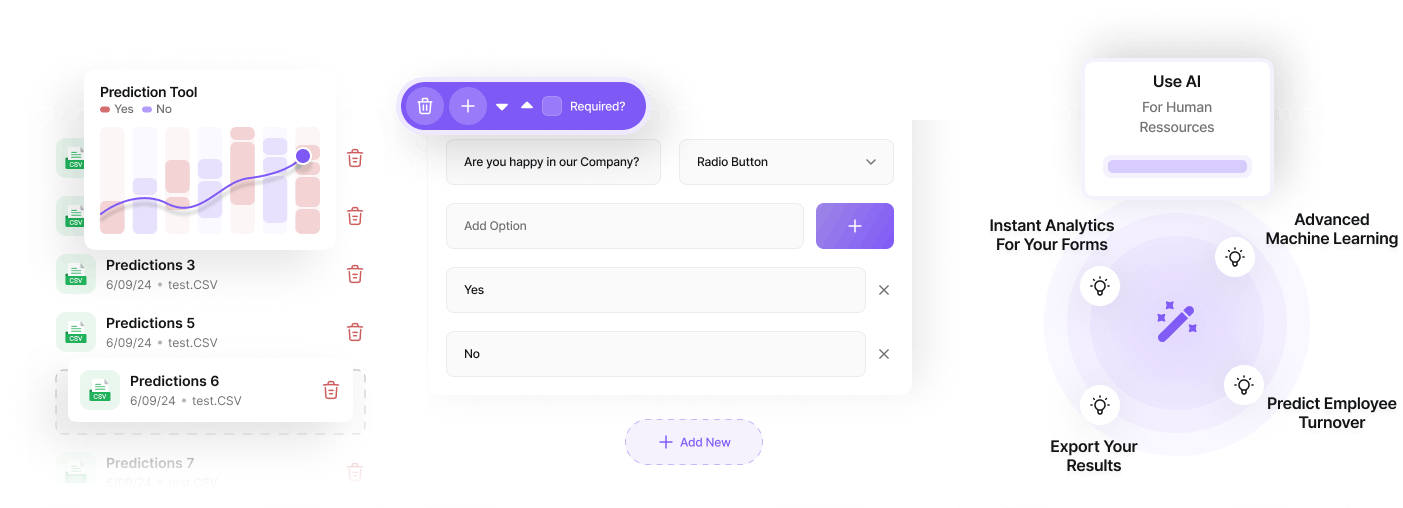
Maximize Retention: Unleash the Power of Predictive Analytics in HR
In today's dynamic business environment, strategic HR management is crucial for maintaining a stable and engaged workforce. As organizations strive to keep their top talent, leveraging advanced tools like HRChurn.com can make a significant difference. This innovative platform utilizes predictive analytics to foresee employee turnover, offering companies the insights needed to act proactively and retain their valuable employees.
The Role of Predictive Analytics in Employee Retention
Predictive analytics, powered by artificial intelligence, has revolutionized the way HR departments approach employee retention. By analyzing patterns and behaviors, HRChurn.com identifies employees at risk of leaving. This foresight allows HR teams to intervene effectively, thereby reducing turnover rates.
How Predictive Analytics Works
HRChurn.com collects and analyzes a multitude of data points related to employee behavior and engagement. These data points include performance metrics, employee feedback, and even social interactions within the workplace. The platform’s sophisticated algorithms then predict which employees are most likely to leave. This prediction model is not just a guess; it is based on comprehensive data analysis, making it a reliable tool for strategic HR management.
Actionable Insights for HR Departments
One of the standout features of HRChurn.com is its ability to provide data-driven insights. The platform generates detailed reports and dashboards, highlighting key metrics and trends. These insights allow HR managers to understand the underlying causes of employee turnover and develop targeted retention strategies. For example, if the data indicates that a particular department has a high turnover rate due to lack of career advancement opportunities, HR can implement specific programs to address this issue.
Implementing Targeted Interventions
Based on the predictive analytics provided by HRChurn.com, HR departments can design and implement targeted interventions. These interventions are tailored to address the specific risks identified, ensuring that efforts to retain employees are both effective and efficient.
Types of Interventions
Interventions suggested by HRChurn.com may include:
- Career Development Programs: Offering training and development opportunities to employees at risk of leaving due to lack of growth prospects.
- Engagement Initiatives: Implementing activities and programs that boost employee morale and engagement.
- Compensation Adjustments: Reviewing and adjusting compensation packages to ensure they are competitive and fair.
These interventions are not just generic solutions but are based on the specific needs and circumstances of the employees identified as being at risk. This targeted approach ensures that resources are used efficiently and effectively.
Benefits of a Proactive Retention Strategy
Adopting a proactive approach to employee retention through predictive analytics offers numerous benefits to organizations. One of the most significant advantages is cost savings. High employee turnover can be incredibly costly, not just in terms of recruitment and training expenses but also in lost productivity and institutional knowledge.
Enhancing Organizational Performance
A stable workforce contributes significantly to organizational performance. Employees who feel valued and see a future within the company are more likely to be engaged and productive. By retaining top talent, companies can maintain a high level of performance and achieve their business objectives more effectively.
Building a Positive Work Environment
A proactive retention strategy also helps in building a positive work environment. When employees see that their employer is committed to their growth and well-being, it fosters a culture of loyalty and engagement. This positive work culture can be a powerful tool in attracting new talent and retaining existing employees.
Real-World Impact of Predictive Analytics
Many organizations that have implemented predictive analytics for employee retention report significant improvements. For instance, a tech company using HRChurn.com saw a 20% reduction in turnover within the first year of implementation. This not only saved the company millions in recruitment and training costs but also led to higher employee satisfaction and engagement levels.
Case Study: A Success Story
A global retail company faced high turnover rates, particularly among their sales staff. By implementing HRChurn.com, they were able to identify that lack of career progression was a key factor driving employees to leave. The company then introduced targeted career development programs and mentorship opportunities. Within six months, the turnover rate in the sales department dropped by 15%, and employee satisfaction scores increased significantly.
The Future of Strategic HR Management
The integration of predictive analytics in strategic HR management is not just a trend but a fundamental shift in how organizations approach employee retention. As technology continues to evolve, the tools and techniques available to HR professionals will become even more sophisticated, offering deeper insights and more effective interventions.
Embracing Technology for Better Outcomes
Organizations that embrace these technological advancements will be better positioned to retain their top talent and maintain a competitive edge. HRChurn.com represents the future of HR management, where data-driven decisions and proactive strategies lead to a more engaged and stable workforce.
Conclusion
In conclusion, maximizing retention through predictive analytics is a game-changer for strategic HR management. Platforms like HRChurn.com provide the tools and insights necessary to identify at-risk employees and implement effective retention strategies. By leveraging these advanced technologies, organizations can significantly reduce turnover rates, save costs, and enhance overall performance. As the business landscape continues to evolve, the adoption of predictive analytics will undoubtedly become an essential component of successful HR management.
Comments on “HR Management”